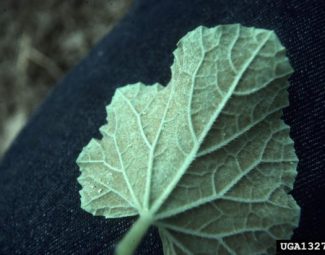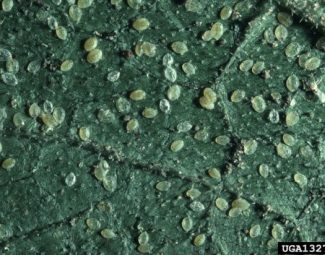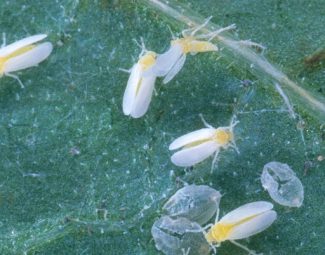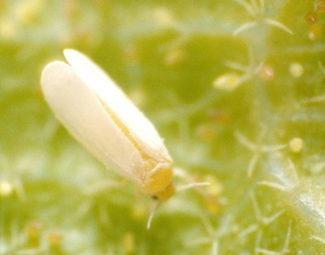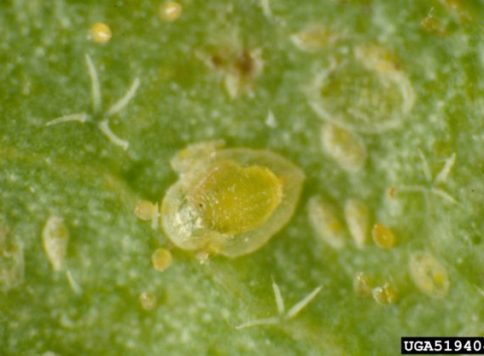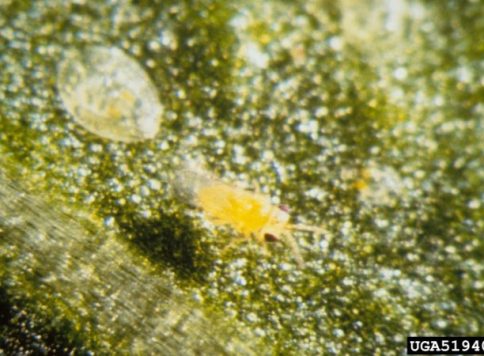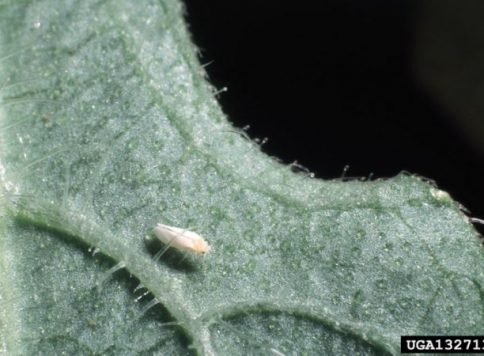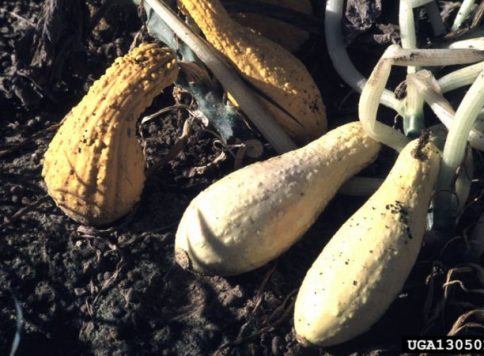Silverleaf Whitefly
Insect Summary Report
Bemesia Argentifolii
General Information
- Silverleaf Whitefly has an extremely large host range of at least 500 species in 74 families. Cucurbits, tomato, potato, cotton, peanut, soybean, peppers, beans, eggplant, cabbage, poinsettia, hibiscus, and chrysanthemum are just a few.
- Possesses high potential for developing resistance to chemical controls.
- Penetrates leaf surface with proboscis and suck plant sap. Excretes sticky honeydew that can cover surface of leaf and serves as medium for black sooty mold, which in turn inhibits photosynthesis and reduces yield.
- Heavy feeding by immature stages has effect of giving leaves of squash varieties a silver appearance and causes irregular fruit development/ripening in tomatoes.
- Are a vector for several plant geminiviruses including yellow leaf curl, tomato mottle, bean golden mosaic, and cassava mosaic.
- Causes physiological disorders such as yellowing of leaves and blanching of stems in lettuce, light roots in carrots, white stems in Brassicas and chlorosis in leaves of many other crops.
- Do not appear to be pheromone driven(2010).
- Virgin females can lay haploid eggs, which only produce males. Mated females can produce male and female progeny.
Life Cycle (20-180 Days)
- Eggs… (6-45 Days) Laid on the undersides of leaves. Turns from white to dark brown as it develops. Oval in shape and tapered toward ends. Obtains moisture from the plant by a short stalk inserted by the female ovipositor.
- Nymph… (8-12 Days) Four nymph stages. First nymph is called “crawler” which refers to its limited motility. Dorsal side is convex; the ventral side is flat against the underside of leaf. All other nymph stages are immobile and are greenish-yellow in color.
- Pupa… (5-6 Days) Distinguished by red eyes. Similar in shape to nymphs. No molt between 4th instar and pupal stage.
- Adult… (10-50 Days) Whitish-yellow in color. 0.82-0.92 mm in length. Emerge from pupa casing leaving a characteristic T-shaped excision. If the exit hole is round, a parasitoid emerged. They can be carried over several miles using wind currents, especially when host plants begin to senesce. Are capable of mating within a few hours of emergence and can lay eggs is less than 24 hours of fertilization. They will probe underside of leaf surfaces until suitable plant sap is found for feeding and/or reproduction. Female adults produce more honeydew than other stages. One female can lay 66-300 eggs during a lifetime.
Over-wintering Strategy
Silverleaf Whitefly does not diapause or enter dormancy. Its life cycle is greatly slowed during cold winter temperatures, which leads to reduction in populations.
Organic Control
- General Info
- Encarsia and Eretmocerus parasitoids are commercially available and can aid in control; especially with augmentative releases.
- Lacewings, minute pirate bugs, big-eyed bugs and some coccinellid species are also predators of whiteflies and can aid in control. All are commercially available and can be released to augment naturally occurring populations.
- Commonly Used Products
- Ferti-Neem Oil
- Ferti-Organics Karanja Oil
- Biorepel (Garlic Oil)
- TriTek (Combine with Ecotrol Plus and spray 2X per week to suppress feeding)
- Ecotrol Plus (Combine with Tritek and spray 2X per week to suppress feeding)
- Mycotrol ESO (Biological)
- BoteGHA ES (Biological)
- Neemix 4.5 (Botanical)
- Cocoon (Kaolin)
- Sil-Matrix
Cultural Control
- Maintain good fertility and mineral balance in plants.
- Whiteflies show preference for plants under stress and/or have high nitrogen content. More feeding is required by whiteflies in plants that are less dense in nutrient content, and thus more honeydew is produced.
- Destroy and remove/degrade crop residue immediately after harvest. Virus infected residue can serve as source for re-infection in later years.
- Use yellow or aluminum coated plastic mulches to reduce populations of whiteflies.
- Smooth leaved and glossy varieties of many plants are less preferred for egg lay than hairy leaved varieties.
More Images of the Silverleaf Whitefly
Bibliography
- Images by Scott Bauer, USDA Agricultural Research Service, Bugwood.org (adult and adult with egg cases)
- Images by Alton N. Sparks, Jr., University of Georgia, Bugwood.org (immatures, eggs (bronze color) on leaf, adult on curburbit, and symptoms on squash)
- Images by Jeffrey W. Lotz, Florida Department of Agriculture and Consumer Services, Bugwood.org (adult and pupa)
- Images by Florida Division of Plant Industry, Florida Department of Agriculture and Consumer Services, Bugwood.org (pupae)
- Image by Gerald Holmes, California Polytechnic State University at San Luis Obispo, Bugwood.org (damage to cauliflower)
- Image by Jeffrey W. Lotz, Florida Department of Agriculture and Consumer Services, Bugwood.org (adult whitelfly)
- http://creatures.ifas.ufl.edu/veg/leaf/silverleaf_whitefly.htm (Sooty mold photo, life cycle, host range, vectors, asexual reproduction, pheromones, sooty mold)
- Csizinszky AA, Schuster DJ, Kring JB. 1997. Evaluation of color mulches and oil sprays for yield and for the control of silverleaf whitefly, Bemisia argentifolii (Bellows and Perring) on tomatoes. Crop Protection 16: 475- 481.
- Vicentini,Sérgio, Faria,Marcos, Oliveira,Maria R.V. de; Screening of Beauveria bassiana (Deuteromycotina: Hyphomycetes) isolates against nymphs of Bemisia tabaci (Genn.) biotype B (Hemiptera: Aleyrodidae) with description of a new bioassay method. Neotropical Entomology vol.30 no.1 Londrina Mar. 2001.
- Gemei Liang; Liu Tong-Xian; Repellency of a kaolin particle film, Surround, and a mineral oil, Sunspray oil, to silverleaf whitefly (Homoptera: Aleyrodidae) on melon in the laboratory; Journal of economic entomology 2002, vol. 95, pp. 317-324 (25 ref.).

